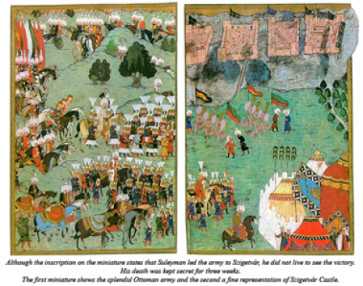The Siege of Szigetvár – August-September 1566
Szöveg: hungariandefence.com | 2011. szeptember 8. 7:31The siege of Szigetvár took place four hundred and forty-five years ago, in August–September 1566. We commemorate the historic event by excerpting from the book „For the Homeland Unto Death – 1100 years” published by Zrínyi Média, which is available in our Digital Library.

Toygun Pasha of Buda captured Fülek in
1554, driving a wedge between the western and
eastern Habsburg-held areas. Later, Hadim Ali,
returning to Buda, attempted to take Szigetvár
(1556). He had less success than he had four years
previously. The castle held out against Hadim
Ali’s siege for fifty days.
Szigetvár ultimately fell to Sultan Suleyman
on his seventh and last campaign in 1566. The
Turks started the war on the pretext of supporting
an expansion into Upper Hungary by
John Sigismund, Voivode of Transylvania. He
sent Pertev Pasha, the Second Vizier, to take
Gyula and he marched with the main army to
Szigetvár, defended by Miklós Zrínyi with 2300
Croatian and Hungarian soldiers. The garrison
of Gyula held out for two months, and Szigetvár
withstood a siege by the Sultan’s army of 50,000
regular soldiers for 38 days.The story of the defenders’
heroic stand and the death of Miklós
Zrínyi as he burst out of the ruined castle were
forged into an essential part of the Hungarian
historical consciousness in a ballad written in
the following century by his great-grandson and
namesake.
The ageing Suleyman did not survive
to see the castle’s fall, dying in his Szigetvár camp
on 6 September, two days before the defenders’
breakout. The capture of Szigetvár marked the
end of the great era of Ottoman conquest of
Hungary.
Suleyman’s successor Selim II signed a peace
treaty with Holy Roman Emperor Maximilian I
in Edirne in 1568. By capturing Szigetvár and
Gyula, the Ottomans had eliminated the forts
threatening their defensive system, completing
their military control of the centre of the country.
A sign of the successes of the Ottoman Empire
is that as King of Hungary, Maximilian I was
obliged to pay a tribute, a kind of tax in effect.
The relationship between the royal part of the
country and Transylvania was settled in a treaty
(1570).
John Sigismund renounced the throne
and recognised Emperor Maximilian as King of
Hungary. If he had no successor, the Principality
would pass to the Habsburg ruler. The Kingdom
of Hungary thus remained a single legal entity,
but its de facto division into three parts became
permanent.
The four decades between 1526 and 1566
proved that the Ottoman Empire was not capable
of permanently occupying the Kingdom of Hungary,
but the Austrian Habsburgs were not capable
of defending it. To Hungary’s misfortune,
the buffer zone between the two empires ran
through the centre of the kingdom, where both
powers set up their own border defence zones.
